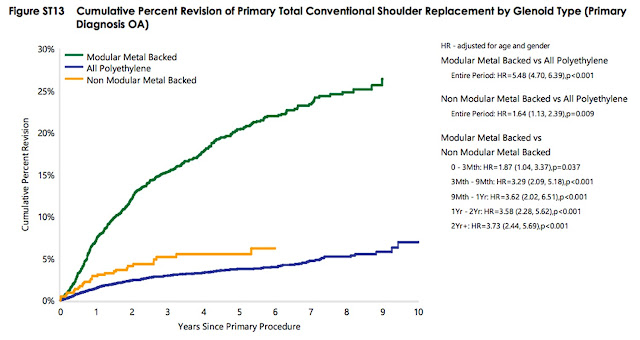These authors evaluated the early clinical and radiographic results in 83 shoulders having total shoulder arthroplasty with an all-polyethylene pegged glenoid component designed for hybrid (biological and cement) fixation.
At a mean followup of 46.7 months (range, 24 to 99 months), the median ASES score was 97 points (range, 43 to 100 points) and the median Oxford score was 48 points (range, 24 to 48 points). The median active forward elevation was 130 (range, 65 to 170), median external rotation was 45 (range, 5 to 80), and median internal rotation was to T11 (range, buttock to T4). Seventy-eight shoulders demonstrated a perfect Lazarus score for radiolucency (0, indicating no radiolucency). Sixty-eight shoulders demonstrated complete osseointegration, with bone ingrowth between all of the flanges seen on coronal CT.
5 demonstrated partial osseointegration; and 10 demonstrated osteolysis around the central peg. Most radiolucent lines were in the inferior pegs of the prosthesis. There were no correlations between the Yian CT scores and either the ASES or Oxford score (rho = 0.13 and 0.07, respectively).
The glenoid inclination and version ranged from 62 to 96 degrees and from -20 to 15 degrees, respectively. No association was found between glenoid inclination or version and the presence of radiolucent lines.
In addition to the 83 implants included in the study, 4 glenoid implants were revised, although only 1 revision was due to aseptic loosening; the others were due to rotator cuff failure, glenoid fracture, and Propionibacterium infection.
Comment: As seen in the figure below from the Australian national joint registry (see this link), all-polyethylene glenoid components have demonstrated the best survivorship. The particular all-polyethylene design discussed in this paper has the advantage of bone ingrowth without the disadvantages of a metal backing.
This all-poly glenoid also has the advantage of easy and bone preserving revision to a reverse, should that become necessary. In the revision. The central hole is drilled out and, if necessary, filled with bone graft followed by the usual insertion of the base plate and glenosphere.
The bone preservation with this type of conversion is in contrast to the amount of bone loss often associated with a failed metal backed component.
Comment: As seen in the figure below from the Australian national joint registry (see this link), all-polyethylene glenoid components have demonstrated the best survivorship. The particular all-polyethylene design discussed in this paper has the advantage of bone ingrowth without the disadvantages of a metal backing.
The bone preservation with this type of conversion is in contrast to the amount of bone loss often associated with a failed metal backed component.
===
The reader may also be interested in these posts:
Information about shoulder exercises can be found at this link.
Use the "Search" box to the right to find other topics of interest to you.
You may be interested in some of our most visited web pages including:shoulder arthritis, total shoulder, ream and run, reverse total shoulder, CTA arthroplasty, and rotator cuff surgery as well as the 'ream and run essentials'






